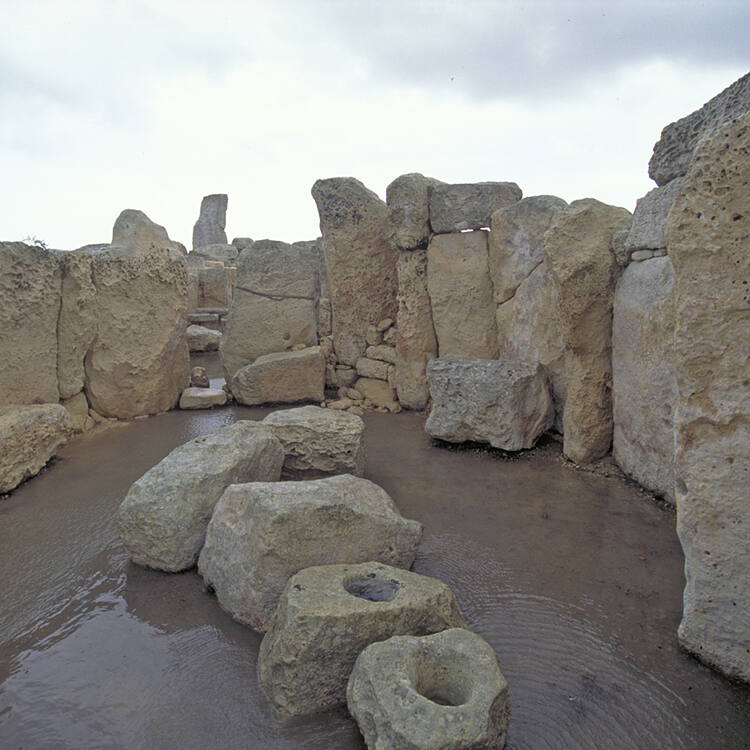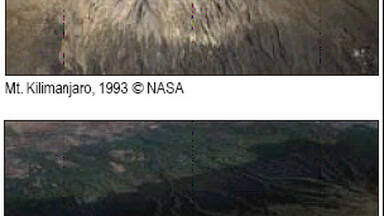Megalithic Temples of Malta
Megalithic Temples of Malta
Seven megalithic temples are found on the islands of Malta and Gozo, each the result of an individual development. The two temples of Ggantija on the island of Gozo are notable for their gigantic Bronze Age structures. On the island of Malta, the temples of Hagar Qim, Mnajdra and Tarxien are unique architectural masterpieces, given the limited resources available to their builders. The Ta'Hagrat and Skorba complexes show how the tradition of temple-building was handed down in Malta.
Description is available under license CC-BY-SA IGO 3.0
Temples mégalithiques de Malte
Les îles de Malte et de Gozo abritent sept temples mégalithiques, chacun témoignant d'un développement distinct. À Gozo, les deux temples de Ggantija sont remarquables pour leur réalisations gigantesques de l'âge de bronze. Dans l'île de Malte, les temples de Hagar Qim, Mnajdra et Tarxien sont des chefs-d'œuvre architecturaux uniques étant donné les ressources très limitées dont disposaient leurs constructeurs. Les ensembles de Ta'Hagrat et de Skorba témoignent de la façon dont la tradition des temples s'est perpétuée à Malte.
Description is available under license CC-BY-SA IGO 3.0
معابد مالطا المبنيّة من الأحجار الضخمة المستعملة في عصور ما قبل التاريخ
في جزيرتي مالطا وغوزو سبعة معابدَ مبنيّة من الأحجار الضّخمة المستعملة في عصور ما قبل التاريخ، يشهد كلُّ معبدٍ منها على تطوّرٍ مميّز. فغوزو تضمّ معبدَي غانتيا الفريدَيْن بسبب بنائهما الهائل الذي يعود الى العصر البرونزي. أما في جزيرة مالطا، فتُعتبر معابد هاغاركين ومونيادري وتركسيان تحفًا هندسية فريدة نظراً للمصادر المحدودة جدًا التي كانت متوفرةً في ذلك الوقت لمعمرّيها. كما تشهد مجموعة تاهاغراط وسكوربا على الطريقة التي أتاحت لتقاليد المعابد أن تدوم في مالطا.
source: UNESCO/CPE
Description is available under license CC-BY-SA IGO 3.0
马耳他巨石庙
在马耳他岛和戈佐岛上发现了七个巨石庙,其中每一个都是独立发展的结果。戈佐岛上的两座詹蒂亚寺庙以其巨大的青铜时代建筑而最引人注目。对当时的建筑者来说,资源非常有限,考虑到这一点,马耳他岛屿上的哈贾尔基姆、姆纳耶德拉和塔克西恩也可以看作是举世无双的建筑精品了。Ta'Hagrat 和 Skorba 建筑表现了马耳他寺庙建筑传统的流传方式。
source: UNESCO/CPE
Description is available under license CC-BY-SA IGO 3.0
Мегалитические храмы Мальты
На островах Мальта и Гоцо найдены семь мегалитических святилищ, каждое из которых имеет свою историю. Два святилища Джгантии на острове Гоцо замечательны своими гигантскими сооружениями, относящимися к бронзовому веку. Святилища Хаджьяр-Им, Мнайдра и Таршьен на острове Мальта – это уникальные архитектурные сооружения, воздвигнутые древними строителями, в распоряжении которых были весьма ограниченные ресурсы. Комплексы Та-Хаграт и Скорба демонстрируют процесс формирования на Мальте традиций сооружения храмов-святилищ.
source: UNESCO/CPE
Description is available under license CC-BY-SA IGO 3.0
Templos megalíticos de Malta
Las islas de Malta y Gozo albergan un total de siete templos megalíticos con características individuales propias bien diferenciadas. En Gozo, los dos templos de Ggantija se destacan por sus gigantescas estructuras de la Edad del Bronce. En Malta, los templos de Hagar Qinn Mnajdra y Tarxien son obras maestras arquitectónicas únicas en su género, habida cuenta de los recursos extremadamente limitados de que dispusieron sus constructores. Los conjuntos de T'Hagrat y de Skorba atestiguan la perdurabilidad de la tradición de construcción de templos en Malta.
source: UNESCO/CPE
Description is available under license CC-BY-SA IGO 3.0
マルタの巨石神殿群
地中海のゴゾ島やマルタ島に築かれ、世界で最も古い石造建造物の一つと考えられています。今世紀にはいって先史時代の神殿が30以上も発見され、六つが世界遺産に登録されています。そのうちの一つマルタ島北西のゴゾ島にあるグガンチャ神殿は、前3000年ごろの建築で、巨大な天然石を積み上げてつくられた神殿遺跡です。source: NFUAJ
Megalithische tempels van Malta
Er bevinden zich op de eilanden Malta en Gozo zeven uit grote stenen opgebouwde tempels, elk het resultaat van een specifieke ontwikkeling. De twee tempels van Ggantija op het eiland Gozo, zijn bijzonder vanwege hun uit het Bronzen Tijdperk stammende bouwwijzen. Op het eiland Malta staan de tempels van Hagar Qim, Mnajdra en Tarxien. Gelet op de beperkte middelen die beschikbaar waren voor de bouwers zijn dit unieke architectonische meesterwerken. De Ta’Hagrat en Skorba complexen laten zien hoe de traditie van de tempelbouw werd door gegeven in Malta. Ze zijn beide essentieel om de grote meesterwerken te begrijpen.
Source: unesco.nl
Outstanding Universal Value
Brief synthesis
The Megalithic Temples of Malta (Ġgantija, Ħaġar Qim, Mnajdra, Skorba, Ta’ Ħaġrat and Tarxien) are prehistoric monumental buildings constructed during the 4th millennium BC and the 3rd millennium BC. They rank amongst the earliest free-standing stone buildings in the world and are remarkable for their diversity of form and decoration. Each complex is a unique architectural masterpiece and a witness to an exceptional prehistoric culture renowned for its remarkable architectural, artistic and technological achievements.
Each monument is different in plan, articulation and construction technique. They are usually approached from an elliptical forecourt in front of a concave façade. The façade and internal walls consist of upright stone slabs, known as orthostats, surmounted by horizontal blocks. The surviving horizontal masonry courses indicate that the monuments had corbelled roofs, probably capped by horizontal beams. This method of construction was a remarkably sophisticated solution for its time. The external walls are usually constructed in larger blocks set alternately face out and edge out, tying the wall securely into the rest of the building. The space between the external wall and the walls of the inner chambers is filled with stones and earth, binding the whole structure together.
Typically, the entrance to the building is found in the centre of the façade, leading through a monumental passageway onto a paved court. The interiors of the buildings are formed of semi-circular chambers usually referred to as apses, symmetrically arranged on either side of the main axis. The number of apses varies from building to building; some have three apses opening off the central court, whilst others have successive courts with four, five, and in one case even six apses.
The temple builders used locally available stone of which they had a thorough knowledge. They used hard coralline limestone for external walls and the softer globigerina limestone for the more sheltered interiors and decorated elements.
Decorated features found within the buildings bear witness to a high level of craftsmanship. These elements consist mainly of panels decorated with drilled holes and bas-relief panels depicting spiral motifs, trees, plants and various animals. The form and layout of these buildings, as well as the artefacts found within them, suggest they were an important ritual focus of a highly organized society.
Criterion (iv): The Megalithic Temples of Malta are remarkable not only because of their originality, complexity and striking massive proportions, but also because of the considerable technical skill required in their construction.
Integrity
All six components of the property are in a reasonably good state of conservation, although the Tarxien complex is less well preserved than the others. All their key attributes are within the boundaries of the property. Surviving vestiges attest to the techniques used in the building of these complex structures, and the knowledge and skill of the people who built them. However, the structures are vulnerable to both material and structural deterioration, so research continues to be conducted to identify preservation strategies for the buildings.
Authenticity
The six components of the property have a high level of authenticity. They consist of well-preserved remains of megalithic temples, with evidence of different phases of construction in Antiquity. The components have been recorded in travel accounts since Early Modern times, while photographic records of some components go back to the early 1900s. Various restoration interventions have been carried out on five of the six components since their excavation. These included moving decorated blocks indoors to protect them from weathering, and capping the surviving blocks with cement. Current conservation interventions are guided by international standards, guidelines and charters.
Protection and management requirements
All six temples are subject to the main legal instrument for the protection of cultural heritage resources in Malta, the Cultural Heritage Act (2002). This Act provides for and regulates national bodies for the protection and management of cultural heritage resources.
Building development and land use are regulated by the Environment and Development Planning Act (2010) and subsequent amendments), which provides for and regulates the Malta Environment and Planning Authority. Since land use is a highly contested issue in the Maltese islands, the safeguarding of the Megalithic Temples and their buffer zone through the careful regulation of building development is therefore an issue of fundamental concern.
Each temple is protected by a buffer zone. The components and their buffer zones are formally scheduled by the Malta Environment and Planning Authority as Grade A archaeological sites, which means they are subject to wide-ranging restrictions of building development. The application of these restrictions varies according to the local context. An important challenge is to establish more rigorous control aimed at mitigating visual impact caused by building development in the vicinity of the buffer zones.
A Management Plan has been drawn up for the inscribed property, which covers each temple and its buffer zone.
The physical conservation of the Megalithic Temples is an area of concern and is the subject of the 2006-2011 Conservation Plan, which established the general principles. The sites were excavated during the course of the 19th and 20th centuries, leaving them exposed to erosion by natural and human causes. Protective shelters are presently the most prudent and effective means available to slow down the deterioration processes that are eroding the monuments. Lightweight, removable protective covers have been implemented as an interim strategy to prolong the life of these buildings, while research continues to identify alternative long-term preservation strategies.

